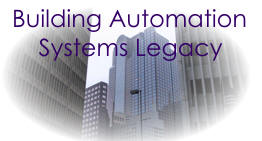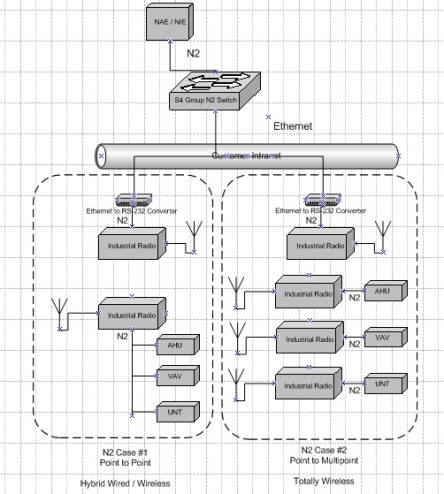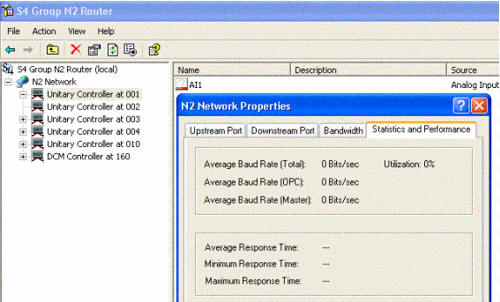June 2004
![]()
AutomatedBuildings.com
[an error occurred while processing this directive]
(Click Message to Learn More)
June 2004 |
[an error occurred while processing this directive] |

The ability to reconfigure and monitor changes made to an automation system in real time is of tremendous importance to building managers. |
Brian Jones |
A building automation system, or BAS, optimizes the administration, operations, and performance of HVAC equipment and alarm systems with purpose built networks and protocols. Most people reading this article are already aware that a BAS greatly increases the interaction of mechanical subsystems within a building, improves occupant comfort, lowers energy use, and allows off-site building control. Modern building automation systems use computer-based monitoring to coordinate, organize and optimize building control sub-systems such as security, fire/life safety, elevators, etc. Over the years, several proprietary building automation network standards have evolved in the marketplace including Siemen’s APOGEE® and Johnson Control’s Metasys®.
|
[an error occurred while processing this directive] |
Proprietary solutions have generally permeated the non-residential HVAC market, limiting the upgrading of and expanding infrastructure to either off the shelf specific vendor compatible products or costly custom solutions. Vendor initiatives to publish their proprietary protocols usually resulted in one-way only open systems with the host system always playing the role of master.
Migration to Open Systems
Flexibility, scalability, and expandability are extremely important when selecting a BAS. The ability to reconfigure and monitor changes made to an automation system in real time is of tremendous importance to building managers. In recent years, truly open protocols like BACnet have been promoted and implemented as their system’s primary protocol by companies such as Automated Logic, Alerton, Andover Controls, Advantech, Delta Controls, Reliable Controls, and others as an alternative to proprietary vendor-specific protocols. More recently, the Continental Automated Buildings Association (CABA) has taken the lead in defining the industry directions for vendor independent open systems. Specifically, the oBIX initiative defines an XML based standard for the future.
The S4 Group fully endorses these initiatives and our S4 Group N2 Router product line offers a middleware approach to migrating new or legacy Johnson Controls Metasys® installations to a truly open systems environment. The S4 Group Inc, in conjunction with Obermeier Software, has developed a line of products that provide a bi-directional media and transport independent open systems interface at the N2 field bus level of the Metasys® system. Having the ability to implement best-of-breed solutions, utilize existing network infrastructure, and retain existing investments in field level gear provides building and system managers with many fiscally positive options that they never had before.
Summary of Product Features and Capabilities
Ability to bring many N2 buses in a large complex building into one virtual N2 bus
Provides media and transport independence for the N2 field bus
Acts as the bus master for each Downstream N2 Network and allows independent adjustment of parameters for each
The Virtual N2 Network acts as a N2-Open device and attaches to any Supervisory Controller N2 bus
Transparent to the existing Metasys® Supervisory Controller
Standard vendor tools are used to configure N2 devices on each N2 bus
Automatically locates and identifies new devices on the N2 bus
Automatically probes N2 devices to identify addressable points
Supports all Johnson Controls Metasys® N2 devices, 9100 series devices, and 3rd party N2 Open devices
Automatically performs N2 address mapping
Provides statistics on N2 bus performance
Remote configuration and administration via MMC
Available in both software-only and turnkey embedded PC configurations
Application
The following are representative applications for the S4 Group’s N2 Router family of products. Each sample case study will highlight the tremendous flexibility the N2 Router provides when either building an automation network from the ground-up or leveraging existing infrastructure as a cost saving measure.
 Extending
the N2 bus over an existing network infrastructure
Extending
the N2 bus over an existing network infrastructure
Challenge
In a large corporation with a multiple building campus, a single automation network might be prohibited by either cost or physical constraints. Being able to centralize building operations in a single location for the entire campus, or company, is an effective way to cut costs and better manage operations.
Solution
The S4 Group N2 Switch allows for the extension of an N2 based automation system over a standard Ethernet network. This opens up the possibility of reaching any location that is connected into the corporate Ethernet or WAN. In addition, for locations that would be difficult to link physically, wireless technologies can be employed as illustrated in the diagram at the right.
The N2 Router also allows for the combining of several N2 based networks into one virtual network, permitting the use of a single supervisory controller on multiple physical networks. This will save money on hardware and reduce the amount of separate infrastructure employed.
Enterprise system integration
Challenge
A large manufacturing corporation has established an Enterprise Management System (EMS) platform based on one of the major SNMP-based managers available on the market today. Since their product yield quantities and product quality are directly related to temperature and humidity variations during critical stages of the manufacturing process they need to bring their HVAC system under the umbrella of their EMS to ensure that the manufacturing process is as effective as possible.
 Solution
Solution
Installing the S4 Group SNMP N2 Router facilitates the publishing of all relevant HVAC data to the EMS via its upstream SNMP interface enabling bi-directional communications between the systems. The SNMP N2 Router can be configured to monitor thresholds on critical data points and generate SNMP traps warning the EMS when any critical parameter that could impact the manufacturing process is going out of specification.
This solution improves the overall quality of the manufacturing process and the resulting product. It also improves yields and minimizes loses due to HVAC related events.
Overview of the N2 Router Architecture
The N2 Router consists of two primary components, the N2 Router Windows Service and the user interface based on Microsoft’s Management Console (MMC) technology. The Windows Service is based upon the same core software framework upon which the Obermeier Software SNMP OPC Gateway products were developed. This is a field tested, mature set of code that provides the foundation of the product. It is implemented as a Windows Service for high reliability, good performance, immunity from traditional Windows applications, and a solid security implementation.
The software may be deployed on a customer provided Windows platform or on one of several commercially available Embedded PC platforms. The software only version is compatible with Windows XP, 2000, and Server 2003. The Embedded PC version is delivered to the customer as a turnkey solution integrated with the hardware platform and Windows CE.Net.
[an error occurred while processing this directive] Benefit to Business
The S4 Group’s family of N2 compatible products presents a tremendous benefit to any organization implementing these solutions. Being able to view the entire BAS as a whole, from one centralized location can reduce MTBF and lower overall operating costs. MTBF is reduced by providing EMS operators with information coming from attached devices concerning factors like temperature, downtime, and overall building performance. From one office, repairs and standard maintenance can be coordinated and dispatched throughout the entire organization.
Costs relating to upgrading are reduced by diminishing the number of physical controllers needed for the N2 network. Costs are also kept down by allowing the transport of the N2 field bus over existing Ethernet and WAN networks. Not having to lay new infrastructure is a boon to the bottom-line.
For further information http://www.thes4group.com/products.htm#N2 Router Family
The full article is available in
PDF in the downloads section where people must
register before they can receive it.
http://www.thes4group.com/Downloads/Downloads.htm#N2%20Router%20Family
Where to purchase
The S4 Group’s Metasys® compatible line of products can be purchased from a number of sources depending on location and needs. In Europe, please contact Obermeier Software, www.obermeier-software.de. For Japan and China, please contact Develo, Ltd., www.develo.tv. For the rest of the world and for integration services, contact The S4 Group, www.TheS4Group.com.
About the S4 Group
In January, 2002 The S4 Group, Inc. was formed with a charter to address the complex challenges associated with integrating legacy Building Automation Systems (BAS), Industrial Ethernet, Process Control, Factory Automation and Industrial Automation Systems into large enterprise customer IT network, management, and security environments, and to each other. The S4 Group, Inc. delivers Software Services and System Solutions to Enterprise-class customers by providing the software tools and integrated systems to maximize their efficiency, productivity, and profitability.
About the Author
Brian Jones is currently a marketing consultant for The S4 Group, Inc where he coauthors the company newsletter, maintains the company's contact library, and conducts extensive research on the BAS, process control, and industrial automation industries. Currently an Architecture student at the University of Wisconsin-Milwaukee, he feels that a building's systems, HVAC, security, IT, etc, must be considered during the preliminary planning phase of development in order to ensure a successful and efficient project.
[an error occurred while processing this directive]
[Click Banner To Learn More]
[Home Page] [The Automator] [About] [Subscribe ] [Contact Us]